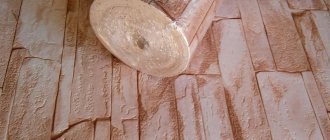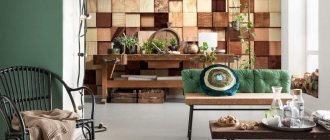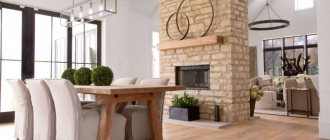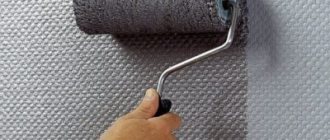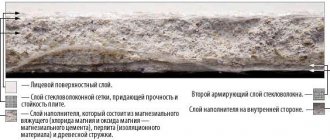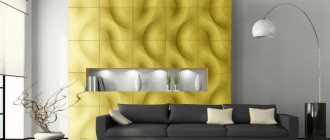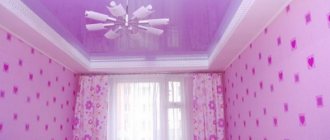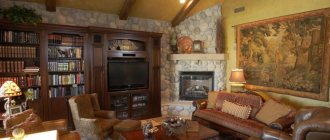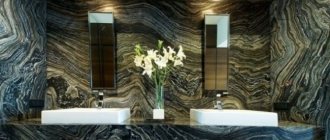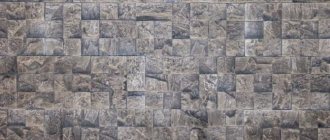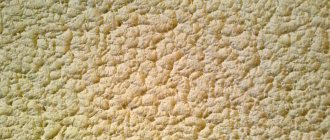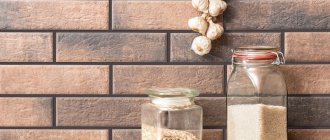12.03.2020
Travertine dates back to ancient times - it began to be used in architecture back in Ancient Rome. Beautiful, easily processed natural stone was widely used for the construction of bridges and aqueducts, the construction of palaces and churches, the construction of houses and thermal baths. Over time, travertine not only has not become outdated, but has also become a very popular finishing material.
What is travertine
Travertine, or calcareous tuff, is a brittle rock that is formed from calcium carbonates. It has a large-porous structure and a rough surface. The coloring is uneven, with streaks and bizarre patterns.
The conditions of formation and the presence of impurities determine the color of the mineral. A completely white stone is very rare. This color means that during the formation of the rock it was almost not affected by environmental factors.
Predominant shades:
- grey;
- beige;
- yellow.
After extraction from the deposit, the color of the rock may change. This is due to the oxidation of metal particles. For example, gray travertine takes on a darker shade due to iron oxidation.
Brown and black colors indicate high strength.
View this post on Instagram
Posted by Elegant Stone (@elegant_stone.ru) Jul 16, 2021 at 1:32 PDT
What does it look like
The description of the stone includes the following characteristics:
- Rough porous, not particularly heavy or dense agglomerates.
- Unevenly colored, streaks and patterns form what is called “harmony of chaos.”
- The shades are mostly beige, but there are gray, sand, even brown, black and red. The color depends on the conditions in which the rock was formed and the impurities in its composition.
The elite is considered a rare pure white stone. And black and brown are the most durable and wear-resistant.
However, the shade of the extracted raw materials may change: metal inclusions oxidize in air. The gray stone turns black, the beige stone looks dark sand.
Formation and extraction of material
The stone is formed from carbonated water sources during the precipitation of calcium carbonate contained in them. In this case, carbon dioxide is released from the water. In caves where underground water flows, the rock forms stalactites - growths hanging from the ceiling, and stalagmites - sinter formations growing from the bottom.
Industrial deposits:
- Kyrgyz;
- Tajikistan;
- Armenian;
- Azerbaijani;
- German;
- Italian.
Kyrgyz travertine is valued for its greatest strength. Iran supplies the breed in yellow and red shades. In Uzbekistan, a mineral with the lowest organic content is mined.
Russian deposits are located in the Leningrad region near Pyatigorsk and Kamchatka.
Extraction is carried out in several ways:
- the most expensive is cutting out pieces from a solid mass, with minimal losses;
- explosive method - many pieces unsuitable for construction remain;
- splitting a solid mass by pumping air under pressure into cut channels - you cannot control the size of the pieces.
Further processing is carried out during construction - the pieces are brought to the required size and polished.
There is a locality called Pamukkale in Turkey. There, travertine deposits on the mountain slopes are a protected natural monument, a UNESCO World Heritage Site.
To watch a video about the extraction and processing of stone at the factory:
Mounting options
There are two ways to install natural travertine slabs on building facades.
- Wet facade. This method is simple and economical for cladding houses using an adhesive base, which is why it is called “wet”. A special construction adhesive is applied to the underside of the slab. Travertine is laid on a prepared, carefully leveled wall surface, maintaining an ideal line of rows. Plates should be selected in small sizes that can be held in place with the help of an adhesive composition. The material can be installed without a seam or leave 2-3 mm spaces between the slabs, which are then painted to match the overall tone of the walls. The wet facade technique is used in most cases by owners of private houses.
- Ventilated facade. This is a more expensive cladding method, as it requires the cost of sheathing. It is installed from metal profiles over the entire surface of the walls. Installing travertine on the sheathing is more difficult than laying it on the plane of the walls using a wet method. To avoid damaging the slabs, the work is entrusted to qualified specialists. The free space between the facing stone and the wall acts as an air cushion, which helps to insulate the building. But in cold regions, for greater effect, a heat insulator is laid under the sheathing. Ventilated facades are installed on public buildings, which can significantly exceed the size of private houses.
Features of real stone
Natural travertine is formed gradually, layer by layer. Constant pressure leads to increased strength, despite the porous structure. Untreated stone is sensitive to chemicals and is damaged by sharp objects.
The artificial material is created from travertine chips, mixing it with various viscous substances: glue, cement, silicate mixture. This is how travertine tiles and plaster are obtained. The difference between artificial materials is their greater strength, resistance to chemicals, and the ability to be painted in different colors.
How to distinguish
You can distinguish natural travertine visually:
- The structure is layered, spongy.
- The pattern is harmonious.
- Untreated rock is easy to scratch or chip off.
The artificial material has a monolithic structure and no pattern. It is difficult to damage it.
Externally, natural stone looks almost like limestone. Limestone is easily distinguished by its dense texture.
Physico-chemical properties of travertine
In appearance and properties the stone is similar to limestone. Only their structure differs - travertine is more spongy. According to the chemical formula, the mineral is calcium carbonate - → {\displaystyle \to } CaCO3. Physical properties:
- porosity;
- softness;
- density 1.8-2.5 grams per cubic centimeter.
Due to its low density, the stone is light, easy to cut and polish.
Properties of the rock that make it suitable for construction:
- ease of processing;
- wear resistance;
- light weight;
- resistance to frost and heat;
- moisture resistance;
- environmental friendliness;
- low price.
Travertine has thermal insulation properties and has low sound conductivity due to its porous structure.
There are several disadvantages - it gets dirty quickly, is unstable to acids and alkalis, and requires special care. Therefore, they prefer to use the mineral for interior decoration.
Laying process
As already mentioned, laying travertine is quite simple and its principle is similar to the technology of surface finishing with any other tile. Of course, there are differences that must be taken into account. The installation process itself can be divided into several stages.
Preparing the surface Natural stone weighs more than other materials, so the wall needs to be further strengthened. To do this, we lay a reinforcing mesh on it and plaster it. Without waiting for complete drying, within a day you can begin finishing with travertine.
A less common option for finishing walls with travertine is laying large fragments of natural stone on the facades. For this purpose, mechanical fasteners in the form of a washer are used. For them, grooves are cut at the ends of the slabs, after which the tiles are attached to the wall both mechanically and using mortar. Thanks to this, the strength of the structure increases significantly.
Areas of application of travertine
The main area of application of stone is construction. It is used to decorate building facades and interior decoration. In agriculture, travertine chips are used for liming the soil.
Stone has been used to build buildings since before our era. Famous surviving buildings include the Roman Colosseum and St. Peter's Vatican Basilica.
Travertine as a finishing material
Travertine tiles are used for interior decoration:
- wall decoration;
- mosaic layouts on the floor;
- design of pool walls;
- laying the floor and walls of the bathroom.
For this purpose, natural or artificial stone is used. The material is well suited for decorating kitchen or bathroom floors because it is moisture resistant and has a low degree of slip.
Travertine plaster is also used to decorate walls. It has advantages over the usual one - fireproof, moisture-resistant, durable, resistant to damage.
By painting plaster in different colors, you can achieve amazing texture and create a unique interior.
Plaster is laid in two ways:
- full plastering - when the surface is completely treated, wait until it dries and apply a pattern or paint;
- partial plastering - involves a combination of treated and untreated surface areas.
Laying travertine plaster requires skill, so it is better not to do it yourself without experience.
Watch detailed video:
Travertine in the interior
The breed has been used for interior decoration since ancient times. There are several directions on how you can decorate a room:
- classic - they lay out mosaics on the floor and walls, decorate stairs and fireplaces;
- Roman style - decorate arches, window and doorways, lay out figures on the floor.
Travertine from different countries is used for finishing. Turkish is distinguished by a variety of pastel shades. It is preferable to use it to decorate the living room and hallway. Iranian stone has bright yellow and red hues. It looks good in the bathroom, kitchen, and on the balcony.
Travertine products are also interior decoration:
- stair balusters;
- mantels;
- floor vases;
- kitchen countertops.
It is recommended to decorate the hallway floor with artificial stone, because natural stone is more sensitive to damage.
View this post on Instagram
Publication from the Master of Repair and Decoration ?? (@mastera_remonta_i_decora) Jul 20, 2021 at 9:36 am PDT
View this post on Instagram
Publication from the Master of Repair and Decoration ?? (@mastera_remonta_i_decora) Jul 20, 2021 at 9:37 am PDT
To watch a video review on the topic:
Mineral in the exterior of buildings
Travertine is used less frequently for the decoration of building facades, since it quickly becomes dirty and becomes saturated with gasoline and industrial exhausts.
The stone is suitable for decorating private houses outside the city. The building, lined with large travertine slabs, looks beautiful. The entrance staircase, path to the house, and flower beds are trimmed with stone.
See also video review about the exterior:
How to care
The Colosseum is already two thousand years old, St. Peter's Basilica is several centuries old. But then there was no gasoline, chemicals or similar destructive factors on Earth.
Today, travertine products need to be carefully looked after:
- To remove dirt and stains, the use of abrasives, hard brushes, and household chemicals is prohibited.
- Even regular vinegar doesn't work.
- Remove dirt with a soft cloth and warm soapy water. Wipe dry immediately.
Facades and other types of exterior require hermetically sealed protection.
Mineral cost
The cost of unprocessed rock is from 100 rubles per hundredweight. The tiles will cost 500-3000 rubles per square meter. Plaster costs 200-1500 for 5 liters. Products are usually made to order, so the price is negotiable.
Travertine is a stone for construction and interior design. It has a pleasant color and textured surface. Resistant to temperature changes, humidity, fire resistant. It is used for external and internal decoration of premises.
Have you used travertine to decorate your home? Share your stories in the comments.
Wide selection of tiles with travertine texture in the ART REAL salon
The current and most popular collections of ceramic tiles and porcelain tiles with travertine texture are presented in the showroom of the ART REAL salon. Here you can not only look and touch the tiles you like from the catalog on the website, but also take advantage of the help of professional designers and consultants. Our salon specialists will select tiles for you in the desired style and budget, help you choose the best option from several, and calculate the required quantity for finishing.
Come buy tiles at the ART REAL salon! We are waiting for you every day!
Tags: Italon , Atlas Concorde , Porcelanosa , Ceramic tiles , For the bathroom , For walls , For floors , For the living room , Porcelain tiles , Stone-like , Universal , Mosaic , Border , Rex , Tagina , Grespania , Cir & Serenissima , Natural stone , Dune , Azahar , FMG STYLE , Antique , Damascus , Classic , Fioranese , Kerama Marazzi , Atlas Concorde Russia , L'antic Colonial , Sal Sapiente , Seranit , Ceramic carpet , Clermont , Travertine , Minoica , Azahar Travertino , Relief Decor , Modern , Cir & Serenissima I travertini , Fioranese Nu_Travertine Controfalda , Tagina Travertini , Glory Travertine , Atlas concorde Travertini , Italon Travertino+ , Rex Travertini Di Rex , Kerama Marazzi New Delhi , L'antic Colonial Travertino , Kerama Marazzi Birmingham , Porcelanosa Travertino , Grespania Coverlam Travertino , Serani t Travertine , Sal Sapiente Softstone , FMG STYLE Maxfine Travertino
